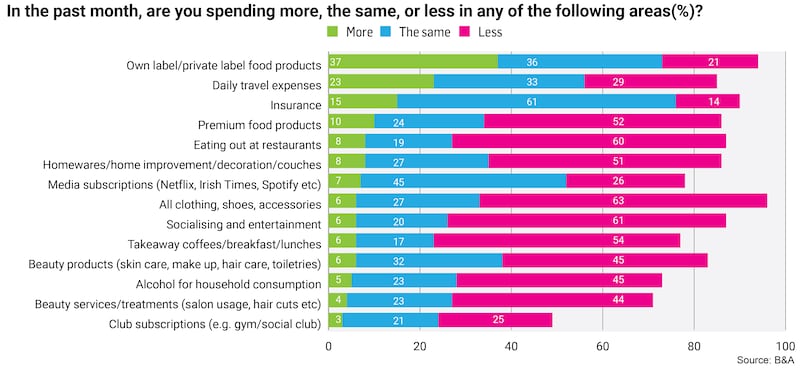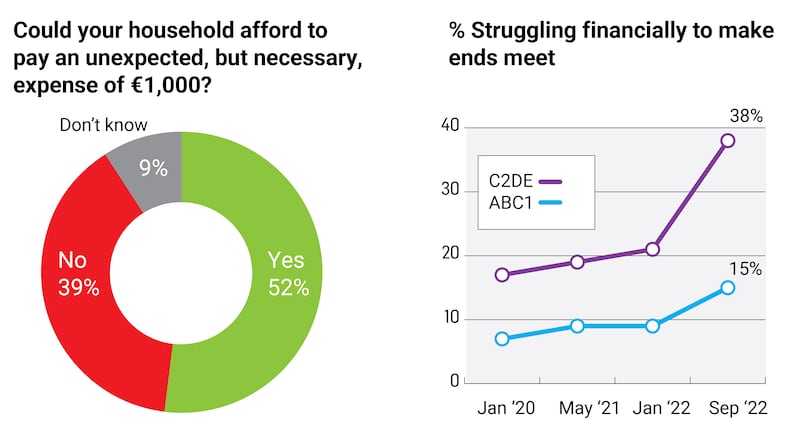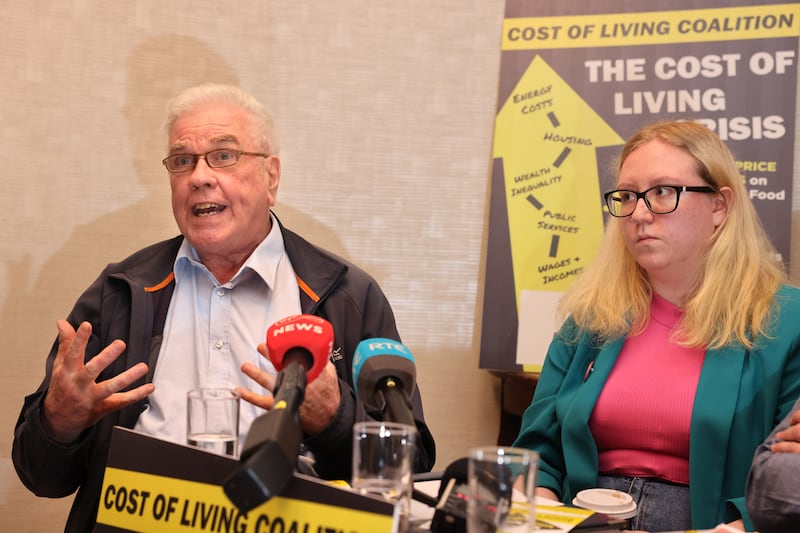Worry is general all over Ireland.
Those with children are more worried than those without. People living outside Dublin are more anxious than those in the capital. The young and the middle-aged are feeling more vulnerable than the old. Women are more concerned than men.
With crowds expected to march through Dublin today in protest at the escalating cost of living, a new poll confirms a widespread sense of despondency as winter approaches.
The headline figures from a new Behaviour & Attitudes (B&A) survey are bleak: more than one million people in Ireland say they are struggling to make ends meet.
READ MORE


Four in five people say they have less money in their pockets compared to this time a year ago. More than one third are economising on food. People are turning to lenders, credit cards, families and friends for a dig-out.
If an unexpected expense of €1,000 befell someone today — a medical emergency, say, a family crisis or a problem with the car — it could not be paid for by two in five people.
As we emerge from the worst constraints of the pandemic, yet another “new normal” has been foisted upon us: One of military invasion in Ukraine, with Russia’s tactical assault leading to a proxy energy war elsewhere.
The B&A poll is, of course, only a snapshot of Ireland’s mood and people’s behaviour in a five-day period during September 2022.
But it does bear out some of the warnings of campaigners, student leaders, trade unions and Opposition parties, among 30 organisations in the Cost of Living Coalition behind today’s demonstration who say people should not be forced to make a decision on whether to eat or heat.
‘Failing state’
One of those organisers, Fr Peter McVerry, this week went as far as to describe Ireland as a “failing state” denying people access to housing, free education, public healthcare and mental healthcare.
“It’s the responsibility of the Government to meet the basic needs of its citizens,” he said, firing a broadside at ministers who, he said, champion our “extraordinarily successful” economy “in one of the highest cost-of-living countries”.
Why, he wondered, would any young person want to stay here. Many are not planning to, answered Beth Reilly, president of the Union of Students in Ireland (USI). Students living in tents and cars and sleeping on couches over a lack of affordable accommodation are preparing for an exodus from the country, she warned.

“We shouldn’t have to leave to afford to live,” she said. “But that is the Ireland we are looking at currently.”
Macdara Doyle, of trade union umbrella organisation Congress, urged radical measures to “prevent an energy crisis morphing into what could become a jobs crisis and a wider economic crisis”.
The B&A poll underlines that portent of a deepening chill on the wider economy. Many have already taken steps and are planning to take more to spend less over the coming months — on everything from takeaway coffees to Netflix subscriptions.
Sentiment, as economists call it, is pessimistic across all demographics. Whether young or old, male or female, “white collar” or “blue collar”, a parent or not, whether living in Rathmines in Dublin, Rathmullan in Co Donegal or Rathcormac in Co Cork, almost half of people living in Ireland have indicated they see no end in sight to current hardships.
Luke Reaper, managing director of B&A, describes the current cost-of-living crisis as “uncharted territory” which “feels very different to the last recession/financial crash of 2008/2009”.
“People are not familiar with this playbook. In a classic recession, the narrative is clear. Jobs are lost, but things get better as jobs return. What will coming out of this crisis look like? The truth is, people don’t have a clue,” he says.
‘Mental block’
“When it comes to energy, some people’s heads are firmly in the sand. There’s a significant mental block in acknowledging the impact this is going to make. People are struggling to understand how to pay up to four times what they are used to for electricity, on top of everything else.
“So people are using classic avoidance tactics. It’s too much for most of us to cognitively take on — we’re pinning all hopes on Government intervention to take the bite out of it. If that doesn’t materialise to a significant degree, most people don’t have a plan B.”
“Undoubtedly people in general are worried”, Reaper adds, with almost everyone, but particularly those with the least disposable income, “putting everything under the microscope”.
“We witnessed an amount of behavioural change during the Covid pandemic, and we are seeing it again,” he says.
[ Budget 2023: What are Irish households looking for?Opens in new window ]
With Budget 2023 due to be announced on Tuesday, Government Buildings will be the scene of long, late-night meetings in the coming days as the Coalition puts the finishing touches to a budget, the likes of which has perhaps not been so anticipated by so many for decades.
“The reassurance from the budget cannot come fast enough, with people fearful for the winter and, indeed, the cost of Christmas,” Reaper says.
“The current crisis requires both a functional and emotional response. Functionally, prices are up and hurting people and hopefully the budget will help at least in part, but we also need emotional supports to lead us get through to the other side.
“The psychological battle needs to be won to avoid talking the economy down, which will worsen the situation further.”
‘Struggling’
The B&A survey was carried out between September 8th and 12th. The 1,005 respondents aged 16 and over are, the pollsters say, a “nationally representative sample” of the population, selected to reflect gender, age, socioeconomic and regional diversity.
Two focus groups were also held in Dublin and Cork with a mix of blue-collar and white-collar workers between September 20th-21st to underpin the results.
B&A found a 73 per cent rise since January, when a similar survey was carried out, in the number of households in Ireland saying they are “struggling” to meet their bills, up to 26 per cent of homes around the country from 15 per cent over just eight months.
Among the section of the population who say they are struggling to make ends meet, almost two-thirds (62%) are aged 25-49
Those who said they were “living comfortably” was down to 16 per cent from 25 per cent over the same period, while there was also a slight dip in people who said they were “getting by financially” from 60 per cent to 58 per cent.
Among the section of the population who say they are struggling to make ends meet, almost two thirds (62 per cent) are aged between 25 and 49. Those in their late 20s and early 30s make up the sharpest rise in financial suffering since January.
More than one third (34 per cent) are aged between 50 and 64.
The findings suggest — and this is borne out over a number of metrics in the poll — that people aged 65 and over are the most financially secure of all people living in Ireland. They now account for 11 per cent of those struggling, and this group showed the lowest rise (four percentage points, compared to a 19 percentage point surge of those aged between 25 and 34).
Pensioners were also the most likely to say they were living in financial comfort (31 per cent), in sharp contrast to those aged 25 to 34 (9 per cent), those aged 35 to 49 (10 per cent), and those aged 50 to 64 (11 per cent).
Starkest differences
One of the starkest differences is the gap between blue-collar and white-collar workers. Those described as professionals made up 15 per cent of those who said they were struggling financially, an increase of six percentage points since January.
But those described as non-professionals account for 38 per cent of those who say they are struggling and represents a 17 percentage point jump.
When it comes to geographical location, those based in Dublin fare best — or least worst — when it comes to making ends meet. Those living in the capital make up 18 per cent of those at the sharpest end of the crisis, up five percentage points since January. Compare that to 29 per cent living outside the capital — a hike of 12 percentage points.
Families in Leinster (31 per cent, up 16 percentage points) are worst impacted, followed by Munster (29 per cent, up 11) and Connacht and Ulster (28 per cent, up 11).
Throughout society, there has been a ‘significant decrease in the perception of having disposable income’
People with children are struggling more than those without, the survey found. Parents and guardians make up 33 per cent of those who say they are struggling, compared with 23 per cent of those without children. Women (30 per cent) are also more likely than men (22 per cent) to be in financial difficulty.
Throughout society, there has been a “significant decrease in the perception of having disposable income”, the pollsters found.
Belts have been tightening steadily since before the pandemic. Weeks before the first lockdown in early 2020, less than a quarter (23 per cent) felt less well off compared to the previous year. That climbed to 34 per cent in May 2021, to 47 per cent in January this year and rose again to 79 per cent this month.
Again, those living outside the capital are feeling the pinch most — 82 per cent, compared to 72 per cent of those in Dublin. The gap is slightly less between parents (83 per cent) and those without children (77 per cent), but still significant.
Spare cash
Just 7 per cent reported having more spare cash in recent weeks, the figure plunging from 26 per cent in May of last year when there was a spike in savings as businesses shuttered to curb the spread of Covid-19.
Those in Dublin were more likely to report having more or the same amount of money in their pockets compared to those outside the capital.
Asked if they could afford to pay an unexpected expense of €1,000 right now, two in five said it was out of the question. That is 1.5 million people.
Women (49 per cent) were much more likely to answer no compared to men (29 per cent). More than half of parents (51 per cent) do not have the money for an unforeseen expense, compared to 34 per cent of those without children.
Well over half (54 per cent) of blue-collar workers could not afford it, against a quarter of professionals.
[ Here’s how much it costs to take a shower or make a cup of teaOpens in new window ]
While around one fifth of those aged 65 and older said they could not meet such an expense, the proportion rises sharply to around half of those aged 25 to 49, and 44 per cent of those aged 50 to 64.
Again, those in Dublin are better protected against financial shocks, with 34 per cent saying they could not meet a sudden demand for payment, compared to 41 per cent outside the capital.
A quarter of people have already dipped into savings over the past month to pay bills. More than two in five (43 per cent) say they do not have the money to save as they used to.
Some 11 per cent are leaning on credit cards, overdrafts and other means of borrowing, but that number surges to 17 per cent among people with children.
Pessimism soaring
It is little surprise, then, that nine in 10 are gloomy about the economic outlook over the coming year, the rate of pessimism soaring from 30 per cent before the pandemic to 89 per cent this month.
All of this does not bode well for businesses and traders. Almost half of people are spending less on essentials such as food, while three-quarters have pulled in the purse strings when it comes to “non-essential” shopping.
In the past month, six in 10 have cut back on eating out, buying clothes, meeting up with friends at the pub or going to the cinema or a concert. More than half (54 cent) have stopped buying takeaway cappuccinos and lattes, while 45 per cent say they are cutting down on drinking alcohol at home.
A similar number (44 per cent) are eliminating hairdressing appointments, while more than half (52 per cent) are holding off on home decor spending. A quarter say they are cancelling gym memberships, with a similar number pressing pause on streaming services such as Netflix and Amazon.
Many are turning to discount retailers to make ends meet, as well as, in some cases, food banks. Around 3 per cent of the population relied on a food parcel over the last month. The youngest (those aged 16 to 24) are twice as likely to turn to charity as other age groups. Again, those aged 65 and over are least represented in the food-bank figures, while parents are over-represented.











